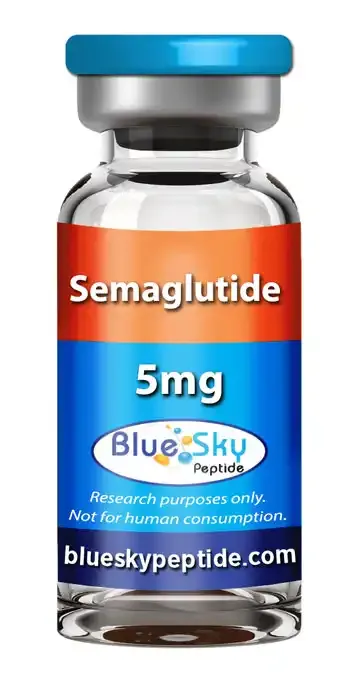45% Off Everything*
Save Now!!

Availability: In stock

| Unit Size | 5mg/vial |
| Unit Quantity | 1 vial |
| Purity (Mass Spectrometry and UV) | 99.17% |
| Molecular Formula | C187H291N45O59 |
| Molecular Weight | 4111.15 |
| Appearance | Lyophilized White Powder |
| Source | Chemical Synthesis |
| Storage |
Lyophilized Semaglutide is Stable at room Temperature for 90 days, however it is best to store in a freezer below - 8c for any extended period of time. After reconstitution Semaglutide should be refrigerated at temperatures not to exceed 35 F. |
| Terms | The products we offer are intended for laboratory research use only. Please familiarize yourself with our terms of service prior to ordering. |
Semaglutide 5mg is a glucagon-like peptide-1 (GLP-1) receptor agonist. It stimulates the release of insulin and suppresses the release of glucagon. Semaglutide has been studied for its potential in vitro use. (1)
One area of interest for semaglutide in vitro studies is its potential to stimulate the production of insulin in pancreatic beta cells. Researchers investigated the effects of semaglutide on isolated human islets, which are clusters of cells in the pancreas that produce insulin. (2)
The researchers found that semaglutide increased the production of insulin in response to glucose stimulation. Semaglutide also increased the expression of genes involved in insulin production and secretion, suggesting that it may have potential as a therapy for type 2 diabetes. (3)
The researchers found that semaglutide increased the expression of genes involved in lipid metabolism and energy expenditure in adipose tissue. Semaglutide also reduced the expression of genes involved in inflammation and adipocyte differentiation, which are processes that contribute to the development of obesity and related metabolic disorders. (4,5)
Another area of interest for semaglutide in vitro studies is in the treatment of non-alcoholic fatty liver disease (NAFLD). NAFLD is a condition in which fat accumulates in the liver, leading to inflammation and scarring.
In a study published in 2022, researchers investigated the effects of semaglutide on liver cells in vitro. The researchers found that semaglutide reduced liver fat accumulation and improved markers of liver function, suggesting that it may have potential as a therapy for NAFLD. (4,5)
While much of the research on semaglutide and cardiovascular health has been conducted in clinical settings, in vitro studies have also been used to investigate the mechanisms by which semaglutide may improve cardiovascular outcomes.
The researchers found that semaglutide reduced the proliferation and migration of vascular smooth muscle cells, which are processes that contribute to the development of atherosclerosis and other cardiovascular diseases. Semaglutide also reduced the production of inflammatory cytokines in vascular smooth muscle cells, suggesting that it may have anti-inflammatory effects in the blood vessels. (6)
While in vitro studies can provide valuable insights into the potential uses of semaglutide, it is important to note that this product is not intended for human consumption. Further research, including animal studies, is needed to fully understand the safety and efficacy of semaglutide for these and other conditions.
In conclusion, semaglutide is a GLP-1 receptor agonist that has shown potential for in vitro use in the treatment of type 2 diabetes and obesity-related metabolic disorders. Further research is needed to fully understand its potential as a therapeutic agent, but in vitro studies suggest that it may be safe and effective for these and other conditions.
References: 1.Mahapatra MK, Karuppasamy M, Sahoo BM. Semaglutide, a glucagon like peptide-1 receptor agonist with cardiovascular benefits for management of type 2 diabetes. Rev Endocr Metab Disord. 2022 Jun;23(3):521-539. 2. Jones B et al. In vivo and in vitro characterization of GL0034, a novel long-acting glucagon-like peptide-1 receptor agonist. Diabetes Obes Metab. 2022 Nov;24(11):2090-2101. 3. Kapitza C, Dahl K, Jacobsen JB, Axelsen MB, Flint A. Effects of semaglutide on beta cell function and glycaemic control in participants with type 2 diabetes: A randomised, double-blind, placebo-controlled trial. Diabetologia. 2017 Aug;60(8):1390-1399. 4. Pontes-da-Silva RM, de Souza Marinho T, de Macedo Cardoso LE, Mandarim-de-Lacerda CA, Aguila MB. Obese mice weight loss role on nonalcoholic fatty liver disease and endoplasmic reticulum stress treated by a GLP-1 receptor agonist. Int J Obes (Lond). 2022 Jan;46(1):21-29. 5. Li R et al. Semaglutide may alleviate hepatic steatosis in T2DM combined with NFALD mice via miR-5120/ABHD6. Drug Des Devel Ther. 2022 Oct 12;16:3557-3572. 6. Jensen DM et al. Semaglutide treatment attenuates vessel remodelling in ApoE-/- mice following vascular injury and blood flow perturbation. Atheroscler Plus. 2022 Jun 4;49:32-41.